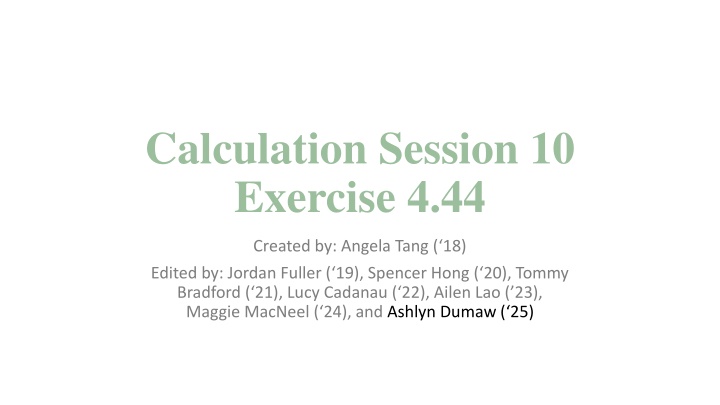
Analysis of Absorbers for Gas Purification
Learn how to analyze an absorber that purifies gases by extracting a compound from air into oil using graphical methods. Understand the operating lines, equilibrium lines, and terms like vapor and liquid mass flow rates. Explore the graphical analysis, known points, and calculations involved in determining oil flow rates for optimal gas absorption in the absorber.
Download Presentation

Please find below an Image/Link to download the presentation.
The content on the website is provided AS IS for your information and personal use only. It may not be sold, licensed, or shared on other websites without obtaining consent from the author. If you encounter any issues during the download, it is possible that the publisher has removed the file from their server.
You are allowed to download the files provided on this website for personal or commercial use, subject to the condition that they are used lawfully. All files are the property of their respective owners.
The content on the website is provided AS IS for your information and personal use only. It may not be sold, licensed, or shared on other websites without obtaining consent from the author.
E N D
Presentation Transcript
Calculation Session 10 Exercise 4.44 Created by: Angela Tang ( 18) Edited by: Jordan Fuller ( 19), Spencer Hong ( 20), Tommy Bradford ( 21), Lucy Cadanau ( 22), Ailen Lao ( 23), Maggie MacNeel ( 24), and Ashlyn Dumaw ( 25)
Goal: Use graphical methods to analyze an absorber that extracts compound Q from air into oil Info: Inlet air and oil compositions, outlet air composition, and A Q/oil-Q/air solubility diagram Where to start: Locate your knowns Consider the meaning of operating lines
What do Absorbers Do? Absorbers purify gases Solute is absorbed from the gas into a liquid stream i.e. A contaminant in gas is absorbed into a liquid e.g. CO2absorbed from air into the solvent MEA Important terms to know V = vapor mass flow rate L = liquid mass flow rate i = into the column (influent) o = out of the column (effluent)
Graphical Analysis of Absorbers Operating Line Connects the streams at the bottom of column to the streams at the top of the column Equilibrium Line Indicates solubility equilibrium Note Operating line for gas absorption lies above the equilibrium line YA XA
What We Know So Far Air out : 100. kg/min air 0.05 kg/min Q 0.05 kg kg Q= Q 0.0005 Oil in : 100 kg air kg air 0 kg kg Q= Q 0 oil Point on the operating line ? kg oil kg oil oil Q Air in : 100. kg/min air 0.70 kg/min Q 0.70 kg kg Q= Q 0.007 Point on the operating line 100 kg air kg air
What We Know So Far 0.0005 YA kg Q/kg air 0 kg Q/kg oil ? kg Q/kg oil 0.007 kg Q/kg air XA
A) Oil Flow Rate with One Eq. Stage Inlet point: (0, 0.0005) Count off 1 stage to reach target Y Outlet point: (0.0027, 0.007) YA ?? ? ?? ??? ?? ? ?? ??? 0.007 0.005 ?? ??? ?? ??? slope= = 2.4 0.0027 0.0 slope = ? ? ratio ? ? ? = (2.4?? ??? ?? ???) 100.?? ??? ? = ??? 1 = 240.?? ??? ??? XA
B) Minimum Oil Flow Rate Minimum flow rate tangent line! YA Inlet point: (0, 0.0005) Outlet point: (0.0064, 0.007) ?? ? ?? ??? ?? ? ?? ??? 0.007 0.005 ?? ??? ?? ??? = 0.10 slope = 0.0064 0.0 ? ? ?? ??? ?? ???) 100.?? ??? ? = ? = (0.10 ??? = 10.?? ??? ??? XA pinch point infinite # of stages
C) # of Stages with 25% Min Flow Rate Minimum flow rate: 10.?? ??? YA ??? Oil flow rate =(10.?? ??? = 12.5?? ??? ???) 1.25 ??? ? ? =12.5 10 100. = 0.125 9 Draw operating line on diagram 8 7 6 Count # of stages to reach Y = 0.007 5 4 3 10 stages 2 1 XA
D) Flow Rate with 4 Eq. Stages Iterative (guess and check) process Draw operating line Count # of stages YA Too many stages increase slope 6 5 4 3 2 1 XA
D) Flow Rate with 4 Eq. Stages Iterative (guess and check) process Draw operating line Count # of stages YA Too many stages increase slope Too few stages decrease slope 3 2 1 XA
D) Flow Rate with 4 Eq. Stages Iterative (guess and check) process Draw operating line Count # of stages YA Too many stages increase slope Too few stages decrease slope Calculate slope for 4-stage process Inlet point: (0, 0.0005) Outlet point: (0.031, 0.007) 4 3 ?? ? ?? ??? ?? ? ?? ??? 0.007 0.005 ?? ??? ?? ??? = 0.21 slope = 2 0.031 0.0 1 ? ? ? = 0.21 100 = 21.?? ??? XA ? = ???
Key Takeaways Understand the meaning of your axes and operating line Label your knowns first (inlets/outlets) Count stages on the equilibrium line Iterate with educated guesses What happens to stage count when you change the operating line? This material will come back to you in Separations (junior spring)!
